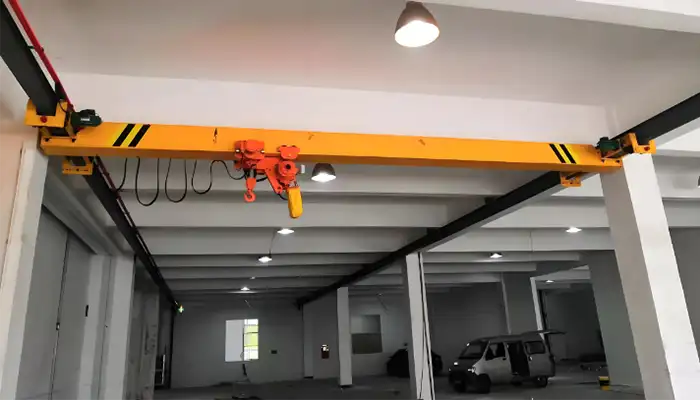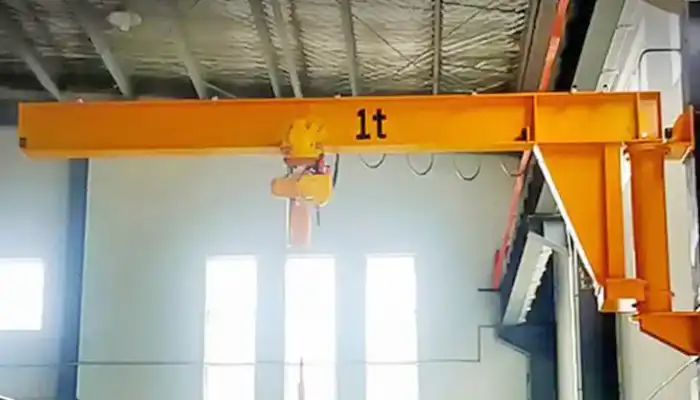1-Ton Overhead Cranes for Sale: Types, Features, Applications
When it comes to material handling in industrial settings, overhead cranes play a crucial role, especially 1 Ton cranes. These versatile machines are designed to lift and move materials efficiently across various industries, from manufacturing plants to warehouses and construction sites. If you're looking for a 1 Ton overhead crane, it's essential to understand the types, features, and applications of these cranes to choose the best fit for your needs.
In this guide, we’ll walk you through the key considerations when selecting a 1 Ton overhead crane. Whether you're in the manufacturing sector or a warehouse, understanding these aspects will help you make a more informed decision. This guide is aimed at industrial facilities, manufacturers, and warehouses seeking to streamline their material handling operations.
Types of 1 Ton Overhead Cranes
There are several types of 1 Ton overhead cranes, each offering unique features to cater to different operational needs. Here’s a breakdown of the most common types:
1 ton overhead crane with top running single girder design
Single Girder Overhead Cranes
These cranes are lightweight, space-efficient, and cost-effective. They are ideal for smaller workshops or production areas with limited ceiling height. If your facility has compact spaces, this type of crane offers a practical solution for lifting materials without taking up too much room.
- Ideal For: Small workshops and production areas with moderate ceiling heights.
Single Girder Under Running Overhead Cranes
Single girder under running overhead cranes are known for their lightweight design and efficient use of space. These cranes are mounted below the runway beams, which allows them to make the most of available ceiling height. The compact structure makes them a perfect solution for smaller facilities or areas with limited headroom. They are also cost-effective, providing excellent value for operations that need to move materials without requiring a large, bulky crane system.
- Ideal For: Small to medium-sized workshops, production areas, or facilities with low to moderate ceiling heights.

Under Running vs. Top Running Cranes
- Under Running Cranes: Mounted underneath the runway beams, these cranes are suited for smaller spaces, allowing you to maximize available room.
- Top Running Cranes: Mounted on top of the beams, top-running cranes offer higher lifting heights and more stability, making them ideal for larger spaces or high-clearance areas.
Choosing between under running and top running depends on the available space in your facility and the required lifting height.
 1 ton portable gantry crane for sale
1 ton portable gantry crane for sale
Portable Gantry Cranes
Portable gantry cranes are mobile and adaptable. They are perfect for temporary lifting needs or construction sites, where flexibility and mobility are key. These cranes can be easily relocated depending on the work environment, making them a versatile option for various applications.
- Ideal For: Construction sites, outdoor work, and temporary lifting tasks.
Jib Cranes (Wall-Mounted or Floor-Mounted)
Jib cranes are often used for localized lifting in tight work areas. They come in wall-mounted or floor-mounted versions, with a rotating arm that allows for easy material handling in confined spaces. If you're working in a workshop or on a production line with limited headroom, a jib crane might be the perfect solution.
- Ideal For: Tight work areas where you need to handle materials in small, confined spaces.

Key Features of 1 Ton Overhead Cranes
When selecting a 1 Ton overhead crane, understanding its features is essential. Here are the key features you’ll want to consider:
- Lifting Capacity: With a 1 Ton lifting capacity, these cranes can handle light to medium-duty tasks. Whether you're lifting small parts or materials, this capacity is sufficient for most everyday applications.
- Traveling Mechanism: You can choose between electric or manual systems, depending on the size of your facility and the required movement speed.
- Control Systems: Cranes come with various control options, including wired, wireless, or pendant controls. Your choice will depend on how the crane is being used and the distance between the operator and the load.
- Speed and Efficiency: Overhead cranes offer varying speeds, allowing you to adjust based on the type of work and material handling requirements. Efficient speed control ensures smooth operations in busy environments.
- Safety Features: Safety is a top priority when choosing an overhead crane. Features such as overload protection, emergency stop buttons, and limit switches ensure safe operations, protecting both the equipment and workers.
- Durability: Depending on your environment, you might need a crane with anti-corrosion options, especially for harsh or outdoor conditions like those found in chemical plants or marine environments.
- Customization: Some cranes offer the ability to customize configurations based on the load requirements, travel distances, and space constraints. This flexibility ensures you get the most suitable crane for your operations.
Applications of 1 Ton Overhead Cranes Across Industries
Different industries have unique material handling requirements, and a 1 Ton overhead crane can be tailored to meet those needs. Below are examples of how 1 Ton overhead cranes are used across various sectors:
Manufacturing Facilities
In manufacturing, overhead cranes are crucial for handling components and materials throughout the production process. A bridge crane, either top running or under running, is often the preferred choice. The facility typically has high ceilings and continuous material handling needs.
- Typical Loads: Small machinery parts, tools, components.
- Coverage & Travel: Wide workspace coverage and long travel distances.
Warehousing and Logistics
In warehouses, overhead cranes are used to lift and move pallets, packages, and other materials. Gantry cranes or monorail cranes are popular because of their mobility and ability to navigate narrow aisles between racks.
- Typical Loads: Boxes, pallets, materials for storage and retrieval.
- Coverage & Travel: Efficient coverage within aisles and short to medium travel lengths.
Construction and Outdoor Applications
For construction sites and outdoor applications, portable gantry cranes or jib cranes are commonly used. Their portability allows them to be relocated easily, providing flexibility on dynamic job sites.
- Typical Loads: Construction materials, pipes, small machinery.
- Coverage & Travel: Flexible coverage across large outdoor areas, depending on crane setup.
Workshops and Maintenance
In smaller workshops, cranes like jib cranes (wall-mounted or floor-mounted) or under-running bridge cranes are perfect for localized lifting tasks. These cranes are particularly useful when space is limited but precision is essential.
- Typical Loads: Small parts, machinery components, tools.
- Coverage & Travel: Limited but precise coverage in workstations.
Hazardous or Corrosive Environments
In environments like chemical plants or marine facilities, cranes with anti-corrosion coatings or explosion-proof features are essential for safe lifting. These cranes are designed to withstand harsh conditions and provide reliable service in hazardous environments.
- Typical Loads: Chemical containers, marine equipment, hazardous materials.
- Coverage & Travel: Specialized designs ensure safety and durability in these environments.
Choosing the Right 1 Ton Overhead Crane for Your Facility
When selecting a 1 Ton overhead crane, it's important to consider both the material handling requirements and the environment in which the crane will operate. Here’s a quick guide to help you decide:
- Light Manufacturing: A monorail or under-running bridge crane is ideal for small, delicate parts and precise lifting in indoor, temperature-controlled environments.
- Heavy Manufacturing: For larger parts like engine components, a top-running bridge crane or jib crane will provide the necessary lifting capacity and coverage in open spaces.
- Outdoor Construction: A portable gantry crane offers the flexibility and ruggedness needed for heavy lifting in outdoor environments.
- Chemical or Marine Environments: If you're working in a hazardous or corrosive environment, invest in an anti-corrosion or explosion-proof crane to ensure safety and durability.
Conclusion
Choosing the right 1 Ton overhead crane is a decision that should be based on your facility’s specific needs, material handling requirements, and environmental conditions. Whether you need a crane for manufacturing, warehousing, or construction, there’s a crane type designed to meet your needs.
Before making your decision, take the time to evaluate your facility’s space, the materials you handle, and the type of crane that will best fit your operations. With the right crane, you can enhance efficiency, safety, and productivity in your workplace.




